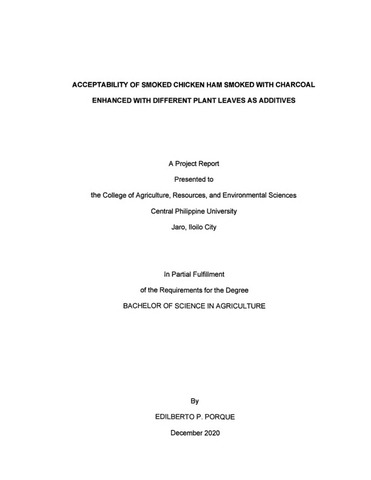Показать сокращенную информацию
Acceptability of smoked chicken ham smoked with charcoal enhanced with different plant leaves as additives
| dc.contributor.adviser | Deloso, Homer | |
| dc.contributor.author | Porque, Edilberto P. | |
| dc.date.accessioned | 2021-07-14T07:36:05Z | |
| dc.date.available | 2021-07-14T07:36:05Z | |
| dc.date.issued | 2020 | |
| dc.identifier.citation | Porque, E. P. (2020). Acceptability of smoked chicken ham smoked with charcoal enhanced with different plant leaves as additives (Unpublished Special paper). Central Philippine University, Jaro, Iloilo City. | en_US |
| dc.identifier.uri | https://hdl.handle.net/20.500.12852/1188 | |
| dc.description | Abstract only | en_US |
| dc.description.abstract | This study was conducted at Brgy. Poblacion, New Lucena, Iloilo on December 5, 2020. Ham evaluation was done at CPU Centennial Village, Pavia, Iloilo. This study was conducted to determine the acceptability of smoked chicken ham enhanced with different plant leaves as additives for smoking materials. There were 3 experimental treatments composed of 3 different leaves namely lemongrass, tamarind, and guava leaves. Each treatment was replicated three times. The smoked chicken ham was evaluated by a taste panel according to a set of criteria. Members of the taste panel were given 10 to 15 minutes to evaluate and rate the samples, food action rating and descriptive analysis. Results revealed that as to the taste preference, smoked chicken ham enhanced with lemongrass, tamarind and guava leaves were rated as more preferred. Furthermore, ANOVA showed no significant differences on the color, saltiness and taste preference of smoked chicken ham. On the other hand, producing smoked chicken ham with tamarind and guava leaves cost less than using lemongrass leaves as additives for smoking material. The commercial ham currently sold in the market costs Php 450.00 per 1 kg which cost Php 198.24, Php 238.24 and Php 245.74 more costly than chicken ham smoked with lemongrass, tamarind, and guava leaves, respectively. Based on the results, it can be concluded that lemongrass, tamarind, and guava leaves can be used as additives for smoking materials in chicken ham given its palatability and acceptability in terms of color and taste preference. | en_US |
| dc.format.extent | vii, 34 leaves | en_US |
| dc.language.iso | en | en_US |
| dc.rights | Attribution-NonCommercial-NoDerivs 3.0 Philippines | * |
| dc.rights.uri | http://creativecommons.org/licenses/by-nc-nd/3.0/ph/ | * |
| dc.subject.ddc | Filipiniana Theses 630.72 P827 | en_US |
| dc.subject.lcsh | Cooking (Chicken) | en_US |
| dc.subject.lcsh | Smoked foods | en_US |
| dc.subject.lcsh | Smoking (Cooking) | en_US |
| dc.subject.lcsh | Cooking (Ham) | en_US |
| dc.subject.lcsh | Food--Sensory evaluation | en_US |
| dc.subject.lcsh | Food additives | en_US |
| dc.subject.lcsh | Spices | en_US |
| dc.subject.lcsh | Cooking (Spices) | en_US |
| dc.subject.lcsh | Lemongrass | en_US |
| dc.subject.lcsh | Lysiloma | en_US |
| dc.subject.lcsh | Guava | en_US |
| dc.subject.lcsh | Leaves | en_US |
| dc.title | Acceptability of smoked chicken ham smoked with charcoal enhanced with different plant leaves as additives | en_US |
| dc.type | Special paper | en_US |
| dc.description.bibliographicalreferences | Includes bibliographical references | en_US |
| dc.contributor.chair | Cabarles, Jaime Jr | |
| dc.contributor.department | College of Agriculture, Resources and Environmental Sciences | en_US |
| dc.description.degree | Bachelor of Science in Agricultural Engineering | en_US |
| local.subject | Tamarind | en_US |
| local.subject.scientificname | Cymbopogon citratus | en_US |
| local.subject.scientificname | Tamarindus indica | en_US |
| local.subject.scientificname | Psidium guajava | en_US |



